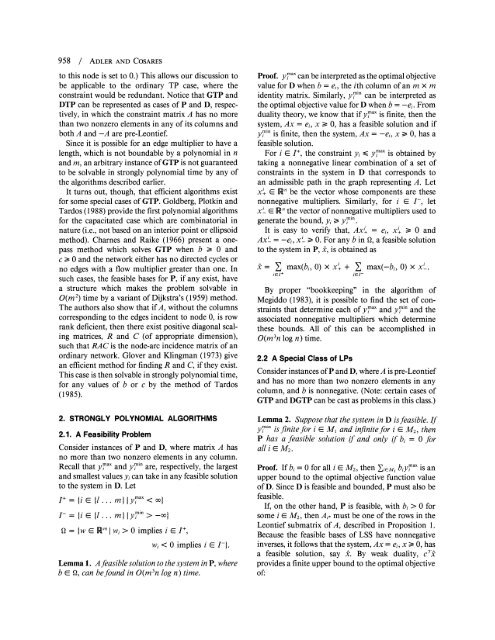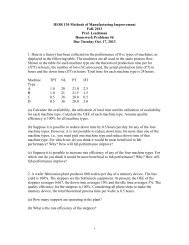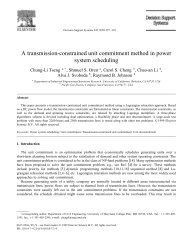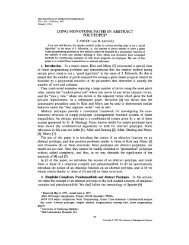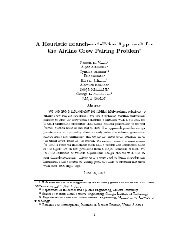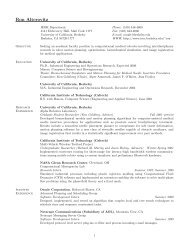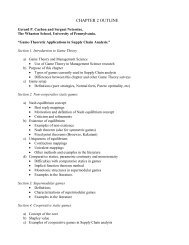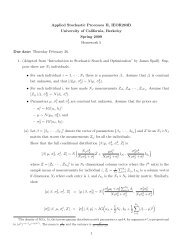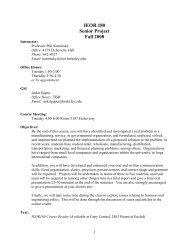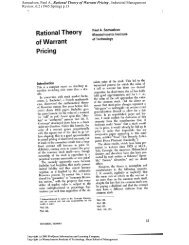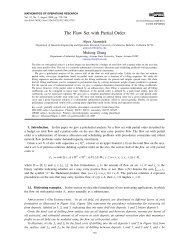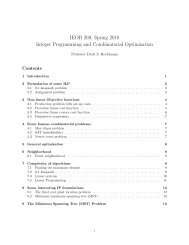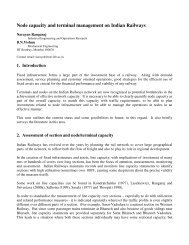a strongly polynomial algorithm for a special class of linear programs
a strongly polynomial algorithm for a special class of linear programs
a strongly polynomial algorithm for a special class of linear programs
Create successful ePaper yourself
Turn your PDF publications into a flip-book with our unique Google optimized e-Paper software.
958 / ADLER AND COSARES<br />
to this node is set to 0.) This allows our discussion to<br />
be applicable to the ordinary TP case, where the<br />
constraint would be redundant. Notice that GTP and<br />
DTP can be represented as cases <strong>of</strong> P and D, respectively,<br />
in which the constraint matrix A has no more<br />
than two nonzero elements in any <strong>of</strong> its columns and<br />
both A and -A are pre-Leontief.<br />
Since it is possible <strong>for</strong> an edge multiplier to have a<br />
length, which is not boundable by a <strong>polynomial</strong> in n<br />
and m, an arbitrary instance <strong>of</strong> GTP is not guaranteed<br />
to be solvable in <strong>strongly</strong> <strong>polynomial</strong> time by any <strong>of</strong><br />
the <strong>algorithm</strong>s described earlier.<br />
It turns out, though, that efficient <strong>algorithm</strong>s exist<br />
<strong>for</strong> some <strong>special</strong> cases <strong>of</strong> GTP. Goldberg, Plotkin and<br />
Tardos (1988) provide the first <strong>polynomial</strong> <strong>algorithm</strong>s<br />
<strong>for</strong> the capacitated case which are combinatorial in<br />
nature (i.e., not based on an interior point or ellipsoid<br />
method). Charnes and Raike (1966) present a onepass<br />
method which solves GTP when b > 0 and<br />
c 3 0 and the network either has no directed cycles or<br />
no edges with a flow multiplier greater than one. In<br />
such cases, the feasible bases <strong>for</strong> P, if any exist, have<br />
a structure which makes the problem solvable in<br />
O(m 2) time by a variant <strong>of</strong> Dijkstra's (1959) method.<br />
The authors also show that if A, without the columns<br />
corresponding to the edges incident to node 0, is row<br />
rank deficient, then there exist positive diagonal scaling<br />
matrices, R and C (<strong>of</strong> appropriate dimension),<br />
such that RAC is the node-arc incidence matrix <strong>of</strong> an<br />
ordinary network. Glover and Klingman (1973) give<br />
an efficient method <strong>for</strong> finding R and C, if they exist.<br />
This case is then solvable in <strong>strongly</strong> <strong>polynomial</strong> time,<br />
<strong>for</strong> any values <strong>of</strong> b or c by the method <strong>of</strong> Tardos<br />
(1985).<br />
2. STRONGLY POLYNOMIAL ALGORITHMS<br />
2.1. A Feasibility Problem<br />
Consider instances <strong>of</strong> P and D, where matrix A has<br />
no more than two nonzero elements in any column.<br />
Recall that y7max and y7mif are, respectively, the largest<br />
and smallest values yi can take in any feasible solution<br />
to the system in D. Let<br />
I+= i E- {l. . m} I Iyim'x < 0oo<br />
I- = {i E- {I. .. m}I I ymln > _-oo<br />
Q = {w E- Rm I wi> 0 implies i E I',<br />
wi < 0 implies i E I-}.<br />
Lemma 1. A feasible solution to the system in P, where<br />
b E Q can be found in O(m3n log n) time.<br />
Pro<strong>of</strong>. y?"ax can be interpreted as the optimal objective<br />
value <strong>for</strong> D when b = ei, the ith column <strong>of</strong> an m x m<br />
identity matrix. Similarly, yTfl can be interpreted as<br />
the optimal objective value <strong>for</strong> D when b = -ei. From<br />
duality theory, we know that if yiax is finite, then the<br />
system, Ax = ei, x > 0, has a feasible solution and if<br />
yT"l is finite, then the system, Ax = -ei, x , 0, has a<br />
feasible solution.<br />
For i E II, the constraint yi < yXa, is obtained by<br />
taking a nonnegative <strong>linear</strong> combination <strong>of</strong> a set <strong>of</strong><br />
constraints in the system in D that corresponds to<br />
an admissible path in the graph representing A. Let<br />
x4 E R' be the vector whose components are these<br />
nonnegative multipliers. Similarly, <strong>for</strong> i E I-, let<br />
Xi E- R' the vector <strong>of</strong> nonnegative multipliers used to<br />
generate the bound, Yi yifl* I<br />
It is easy to verify that, Ax' = ei, xJ > 0 and<br />
Ax_ = -ei, x_ , 0. For any b in Q, a feasible solution<br />
to the system in P, xk, is obtained as<br />
x= max(bi, 0) x x+ + E max(-bi, 0) x x-.<br />
iEi+ i+I<br />
By proper "bookkeeping" in the <strong>algorithm</strong> <strong>of</strong><br />
Megiddo (1983), it is possible to find the set <strong>of</strong> constraints<br />
that determine each <strong>of</strong> y7max and yimi and the<br />
associated nonnegative multipliers which determine<br />
these bounds. All <strong>of</strong> this can be accomplished in<br />
O(m3n log n) time.<br />
2.2 A Special Class <strong>of</strong> LPs<br />
Consider instances <strong>of</strong> P and D, where A is pre-Leontief<br />
and has no more than two nonzero elements in any<br />
column, and b is nonnegative. (Note: certain cases <strong>of</strong><br />
GTP and DGTP can be cast as problems in this <strong>class</strong>.)<br />
Lemma 2. Suppose that the system in D is feasible. If<br />
yinax is finite <strong>for</strong> i E M1 and infinite <strong>for</strong> i E M2, then<br />
P has a feasible solution if and only if bi = 0 <strong>for</strong><br />
all i E M2.<br />
Pro<strong>of</strong>. If bi = 0 <strong>for</strong> all i E M2, then XiEM, biy Tax is an<br />
upper bound to the optimal objective function value<br />
<strong>of</strong> D. Since D is feasible and bounded, P must also be<br />
feasible.<br />
If, on the other hand, P is feasible, with bi > 0 <strong>for</strong><br />
some i E M2, then Ai* must be one <strong>of</strong> the rows in the<br />
Leontief submatrix <strong>of</strong> A, described in Proposition 1.<br />
Because the feasible bases <strong>of</strong> LSS have nonnegative<br />
inverses, it follows that the system, Ax = ei, x > 0, has<br />
a feasible solution, say x. By weak duality, c t<br />
provides a finite upper bound to the optimal objective<br />
<strong>of</strong>:


